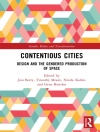From the earliest periods of architecture and building, architects’ actions have been conditioned by rules, regulations, standards, and governance practices. These range from socio-cultural and religious codes seeking to influence the formal structure of settlement patterns, to prescriptive building regulations specifying detailed elements of design in relation to the safety of building structures. In Architectural Design and Regulation the authors argue that the rule and regulatory basis of architecture is part of a broader field of socio-institutional and political interventions in the design and development process that serve to delimit, and define, the scope of the activities of architects.
The book explores how the practices of architects are embedded in complex systems of rules and regulations. The authors develop the understanding that the rules and regulations of building form and performance ought not to be counterpoised as external to creative processes and practices, but as integral to the creation of well-designed places. The contribution of Architectural Design and Regulation is to show that far from the rule and regulatory basis of architecture undermining the capacities of architects to design, they are the basis for new and challenging activities that open up possibilities for reinventing the actions of architects.
Daftar Isi
Illustrations.
Tables.
The Authors.
Foreword.
Preface.
Illustration Credits.
PART I THE CONTEXT OF REGULATION.
1 Regulation, Rule, and Architecture: Introductory Comments.
1.1 Introduction.
1.2 The autonomy of architecture and the design process.
1.3 The study of regulation and the practices of architects.
1.4 Conclusions.
2 The Rule and Regulation of Building Form and Performance.
2.1 Introduction.
2.2 Early settlement and the codification of design
practice.
2.3 Spatial codes and the regularisation of design and
development.
2.4 Hygienic spaces and the efficiency of design.
2.5 From the regulatory society to the regulatory state.
2.6 Conclusions.
3 Urban Design and the Rise of the (De)Regulatory Society.
3.1 Introduction.
3.2 Self-activation and the (re-)regulation of design
activities.
3.3 Regulating design: an evaluation of leading assumptions.
3.4 Conclusions.
PART II THE PRACTICES OF REGULATION.
4 Learning about Regulation.
4.1 Introduction.
4.2 Discipline, education, and the creation of the
architect-subject.
4.3 Pedagogy and the acculturation of architects: evidence from
the field.
4.4 Conclusions: towards relational pedagogies.
Case Study A: Rethinking Education: Evidence from a Focus
Group.
5 Working with Regulation.
5.1 Introduction.
5.2 Systems of control and the management of the design
process.
5.3 The interrelationships between regulations and the practices
of architects.
5.4 Conclusions.
Case Study B: Straw-Bale Building in the USA: Negotiating the
Codes.
6 Risk and the Regulation of the Design Process.
6.1 Introduction.
6.2 Building form, performance and the regulation of risk.
6.3 Risk, regulation, and architecture: some evidence from the
UK.
6.4 Conclusions.
Case Study C: Regulating the Design Process: a Risky
Business?
PART III THE SCOPE OF REGULATION.
7 The Role of Project Actors in Influencing Design.
7.1 Introduction.
7.2 Redefining roles in the UK design and construction
industry.
7.3 Contemporary project teams and the rise of the new
professional.
7.4 Responding to change: architects’ experiences of a
changing profession.
7.5 Conclusions.
Case Study D: Traces of Regulation: the School of Sport,
Exercise and Health Sciences, Loughborough University.
8 The Coding of Design and Architecture.
8.1 Introduction.
8.2 Modernity, urbanism and the revival of urban character.
8.3 The influence of design coding on the practices of
architects.
8.4 Conclusions.
Case Study E: The Use of Design Codes in Two English Towns.
9 Regulation and the Practices of Architects: Concluding
Thoughts.
Endnotes.
Appendix: Research Design and Methods.
References.
Index.
Tentang Penulis
Rob Imrie is Professor of Geography at King’s College London. He is author and co-author of five books, and has written widely in international journals on issues ranging from urban policy and regeneration to disability and the built environment. His background is in geography, sociology, and planning studies and he has a doctorate in industrial sociology.
Emma Street has recently completed a doctorate in urban geography at King’s College London. Her background is in geography, and she has a masters’ degree in public policy. Her research interests include, urban planning and politics, the role of the private sector in place-shaping, and architecture and the built environment.












